RBSE Solutions for Class 12 Maths Chapter 6 Application of Derivatives Ex 6.5
Rajasthan Board RBSE Solutions for Class 12 Maths Chapter 6 Application of Derivatives Ex 6.5 Textbook Exercise Questions and Answers.
Rajasthan Board RBSE Solutions for Class 12 Maths in Hindi Medium & English Medium are part of RBSE Solutions for Class 12. Students can also read RBSE Class 12 Maths Important Questions for exam preparation. Students can also go through RBSE Class 12 Maths Notes to understand and remember the concepts easily.
RBSE Class 12 Maths Solutions Chapter 6 Application of Derivatives Ex 6.5
Question 1.
Find the maximum and minimum values, if any, of the following functions given by:
(i) f(x) = (2x - 1)2 + 3
Answer:
Given, f(x) = (2x - 1)2 + 3
∵ (2x - 1)2 > 0 f(x) has no maximum value.
But minimum value of (2x - 1)2 = 0
∴ 2x - 1 = 0 ⇒ x = \(\frac{1}{2}\) then minimum value of function will be 3.
(∵ f\(\left(\frac{1}{2}\right)\) = 3)

(ii) f(x) = 9x2 + 12x + 2
Answer:
Given, f(x) = 9x2 + 12x + 2
⇒ f(x) = (3x)2 + 2 × 3x × 2 + 4 - 4 + 2
⇒ f(x) = (3x + 2)2 - 2
Again, (3x + 2)2 > 0.
Thus, function has rio maximum value.
Now, minimum value of (3x + 2)2 is zero.
∴ 3x + 2 = 0 ⇒ x = - \(\frac{2}{3}\), then minimum value of function is - 2.
(∵ f\(\left(-\frac{2}{3}\right)\) = - 2)
(iii) f(x) = - (x - 1)2 + 10
Answer:
Given, f(x) = - (x - 1)2 + 10
- (x - 1)2 < 0, thus function has no minimum value.
Maximum value of - (x - 1)2 is 0.
∴ - (x - 1)2 = 0 ⇒ x = 1 then maximum value of function is 10.
(∵ f(1) = 0 + 10 = 10)
(iv) g(x) = x3 + 1
Answer:
Given, g(x) = x3 + 1
g(x) = x3 + 1, x ∈ R
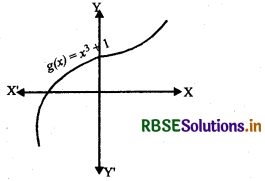
As value of x increases, g(x) also increases. Thus, g(x) has no maximum value similarly as x decreases value of g(x) also decreases. So, g(x) has no minimum value.
Alternatively:
g(x) = x3 + 1
⇒ g’(x) = 3x2, x ∈ R (∵ x2 > 0, ∀ x ∈ R)
⇒ gA(x) > 0 so function is increasing.
Thus, function has neither maximum nor minimum value.

Question 2.
Find the maximum and minimum values, if any, of the following functions given by:
(i) f(x) = |x + 2| - 1
Answer:
Given, f(x) = |x + 2| - 1
|x + 2| > 0 thus f(x) has no maximum value.
Again, minimum value of |x + 2| is 0.
∴ |x + 2| = 0 ⇒ x = - 2 then minimum value of f(x) is - 1.
(∵ f(- 2) = |- 2 + 2| - 1 = 0 - 1 = - 1)
(ii) g(x) = - |x + 1| + 3
Answer:
Given, g(x) = - |x + 1| + 3
- |x + 1| < 0, so function has no minimum value.
Again, maximum value of -|x + 1| is 0.
∴ - |x + 1| = 0 ⇒ x = - 1 then, maximum value of g(x) is 3.
[∵ g( - 1) = - |- 1 + 1| + 3 = 3]
(iii) h(x) = sin (2x) + 5
Answer:
Given, h(x) = sin 2x + 5
Maximum value of sin (2x) is 1.
∴ Maximum value of h (x) = 1 + 5 = 6
Again, minimum value of sin (2x) is - 1.
∴ Minimum value of h(x) is - 1 + 5 = 4
(iv) f(x) = |sin 4x + 3|
Answer:
Given f(x) = |sin 4x + 3|
Maximum value of sin 4x is 1.
∴ Maximum value of f(x) is |1 + 3| = 4
Again, minimum value of sin 4x is - 1.
∴ Minimum value of f(x) is |- 1 + 3| = |2| = 2
(v) h(x) = x + 1, x ∈ (- 1, 1)
Answer:
Given, h(x) = x + 1; x ∈ (- 1, 1)
∵ x ∈ (- 1, 1), so - 1 < x < 1 Then, h(x) > 0 is as x increases value of h(x) will be increased.
Again, h(x) <0 is as x decreases value of h(x) will be decreased.
∴ h(x) is increasing.
Thus, it has no maximum or minimum value.
Question 3.
Find the local maxima and local minima, if any, of the following functions. Find also the local maximum and local minimum values, as the case may be:
(i) f(x) = x2
Answer:
Given f(x) = x2
⇒ f(x) = 2x
For local maximum or minimum value f'(x) = 0.
f’(x) = 0 ⇒ 2x = 0 ⇒ x = 0
For x = - 0.1 (left side of 0)
f'x = 2(- 0.1) = - 0.2 < 0

For x = 0.1 (right side of 0) f’(x) = 2(0.1) —0.2>0
∵ Sign of f'(x) changes from - ve to + ve.
Thus, x = 0 is local minimum point and local minimum value of f is 0.
(ii) g(x) = x3 - 3x
Answer:
Given, g(x) = x3 - 3x
⇒ g’(x) = 3x2 - 3
For local maximum or minimum g’ (x) = 0
g'(x) = 0
⇒ 3x2 - 3 = 0
⇒ 3(x2 - 1) = 0
⇒ x2 - 1 = 0
⇒ x = ±1
Thus, x = -1, 1

(a) For x = - 1
Taking x = - 1.1 (right of - 1)
g’(x) = 3(-1.1)2 - 3 = 3 × 1.21 - 3 .
= 3.63 - 3 = 0.63 > 0
Taking x = - 0.9(right of - 1)
g’(x) = 3(- 0.9)2 - 3 = 3 × 0.81 - 3
= 2.43 - 3 = - 0.57 < 0
Sign of g’ (x) changes from + ve to - ve.
x = - 1 is local maximum point.
At x = - 1, maximum value of function g
= (- 1)3 - 3(- 1) = - 1 + 3 = 2

(b) For x = 1
Taking x = 0.9 (right of 1)
g’(x) = 3(0.9)2 - 3 = 3 × 0.81 - 3
= 2.43 - 3 = - 0.57 < 0
Taking x = 1.1 (right of 1)
g’(x) = 3(1.1)2 - 3 = 3 × 1.21 - 3
= 3.63 - 3 = 0.63 > 0

At x = 1, g’ (x) changes - ve to + ve sign.
Thus, x = 1 is local minimum point.
At x = 1, local minimum value of function
= (1)3 - 3 × 1 = 1 - 3 = - 2
(iii) h(x) = sin x + cos x, 0 < x < \(\frac{\neq}{2}\)
Answer:
h(x) = sin x + cos x, 0 < x < \(\pi / 2\)
Given h(x) = sin x + cos x
⇒ h’(x) = cos x - sin x
For local maximum/ minimum h‘(x) = 0
∴ h’(x) = 0
⇒ cos x - sin x = 0
⇒ cos x = sin x ⇒ tan x = 1
⇒ tan x = tan π/4
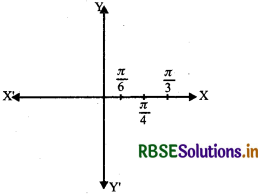
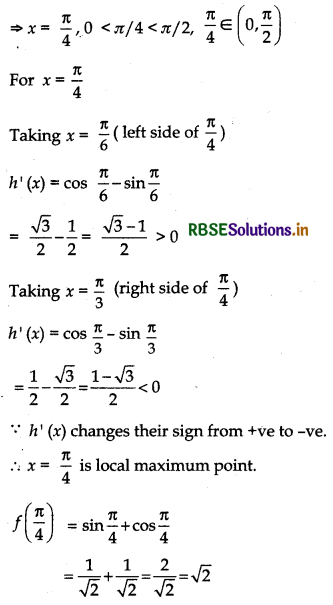
(iv)f(x) = sin x - cos x, 0 < x < 2π,
Answer:
Given, f(x) = sin x - cos x, 0 < x < 2π
f (x) = sin x - cos x
⇒ f’ (x) = cos x - (- sin x) = cos x + sin x
For local maximum or minimum f'(x) = 0
f’(x) = 0 ⇒ cos x + sin x = 0
⇒ cos x = - sin x ⇒ tan x = - 1
⇒ x = \(\frac{3 \pi}{4}, \frac{7 \pi}{4}\)

(a)
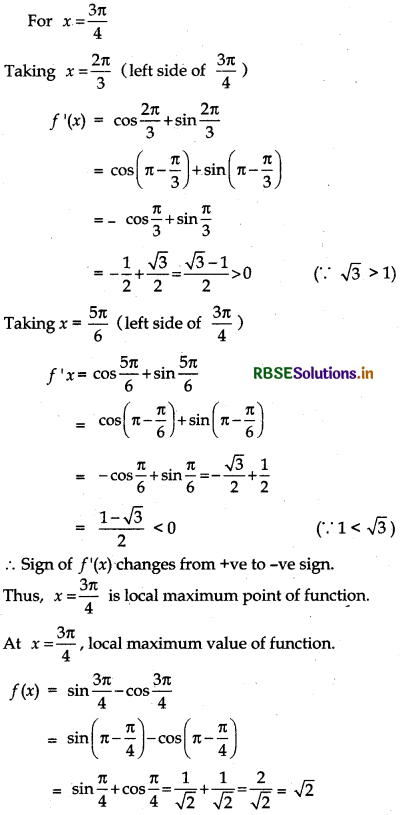
(b)
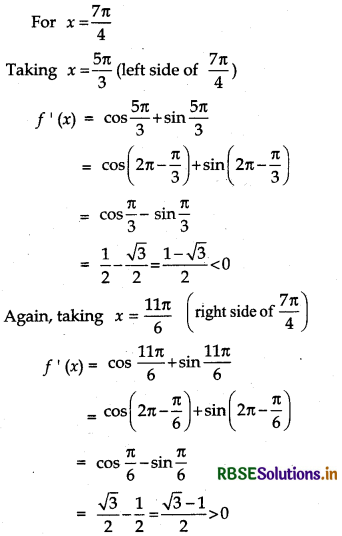
Sign of f' (x) changes from -ve to +ve. Thus x = \(\frac{7 \pi}{4}\) is local minimum point of function.
At x = \(\frac{7 \pi}{4}\), local minimum value of function
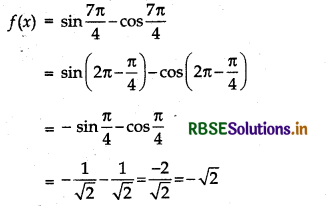
(v) f (x) = x3 - 6x2 + 9x + 15
Answer:
Given, f(x) = x3 - 6x2 + 9x + 15
f'(x) = 3x2 - 12x + 9
For local maximum or minimum f’(x) = 0
∴ f’(x) = 0 ⇒ 3x2 - 12x + 9 = 0
⇒ 3(x2 - 4x + 3) = 0 ⇒ 3(x - 3) (x - 1) = 0
⇒ x - 1 = 0 or x - 3 = 0
⇒ x = 1 or x = 3
(a) For x = 1
Taking x = 0.9 (left side of 1)

f’(x) = 3(0.9)2 - 12(0.9) + 9
= 3 × 0.81 - 10.8 + 9
= 2.43 - 10.8 + 9 = 0.63 > 0
Taking x = 1.1 (Right side of 1)
f'(x) = 3(1.1)2 - 12(1.1) + 9
= 3 × 1.21 - 13.2 + 9 = 3.63 - 13.2 + 9
= 12.63 - 13.2 = - 0.57 < 0
Sign off (x) changes from +ve to -ve. Thus, x = 1 is local maximum point of function.
Thus, at x =1, local maximum value of function
f(x) = 13 - 6(1)2 + 9 × 1 + 15
= 1 - 6 + 9 + 15 = 19

(b)For x = 3
Taking x = 2.9 (left side of 3)

f '(x) = 3(2.9)2 - 12(2.9) + 9
= 3 × 8.41 - 34.8 + 9
= 25.23 - 34.8 + 9
= 34.23 - 34.8
= - 0.57 < 0
Taking x = 3.1 (right side of 3)
f ‘(x) = 3(3.1)2 - 12(3.1) + 9
= 3 × 9.61 - 37.2 + 9
= 28.83 - 37.2 + 9
= 37.83 - 37.2 = 0.63 > 0
Sign of f’(x) changes from -ve to +ve.
∴ x = 3 is local minimum point of function.
At x = 3, local minimum value of function
f(x) = 33 - 6(3)2 + 9 × 3 + 15
= 27 - 54 + 27 + 15 = 15
(vi) g(x) = \(\frac{x}{2}+\frac{2}{x}\), x > 0
Answer:
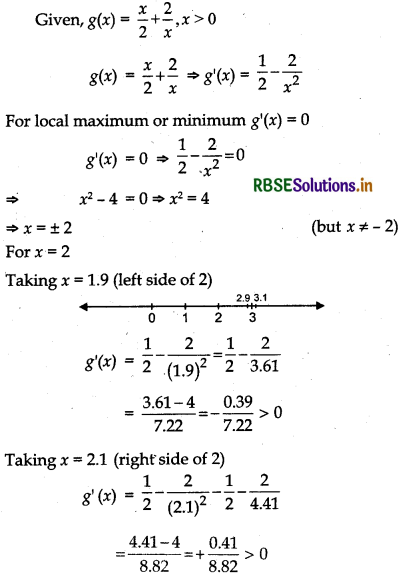
Sign of g’ (x) changes from -ve to +ve.
x = 2 is local minimum point of function g.
At x = 2, local minimum value of function g
g(x) = \(\frac{2}{2}+\frac{2}{2}\) = 1 + 1 = 2
(vii) g(x) = \(\frac{1}{x^{2}+2}\)
Answer:
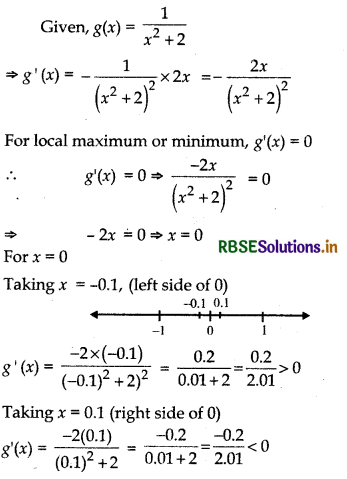
Sign of g’ (x) changes from -ve to +ve.
x = 0 is local minimum point of function g.
At x = 0, local minimum value of function g
g(x) = \(\frac{1}{(0)^{2}+2}=\frac{1}{2}\)

(viii) f(x) = x\(\sqrt{1-x}\), x > 0
Answer:
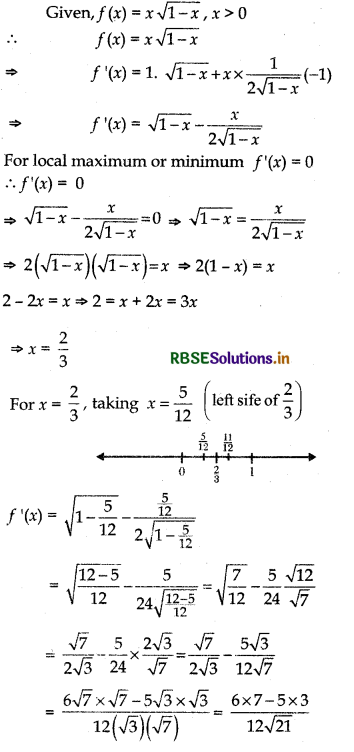
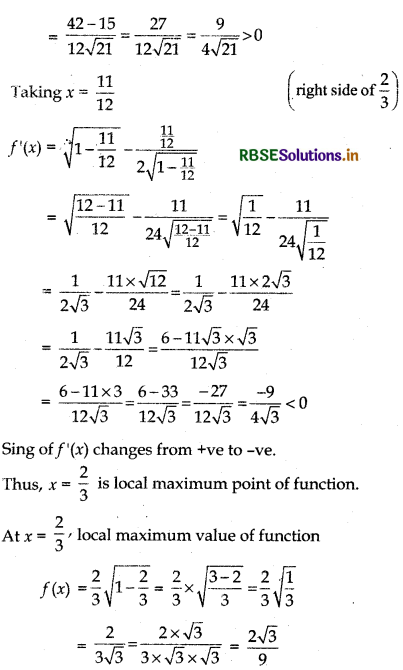
Question 4.
Prove that the following functions do not have maxima or minima:
(i) f(x) = ex
Answer:
Given, f' (x) = ex ⇒ f'(x) = ex > 0, x ∈ R
Thus, f(x) remains positive for any x.
∴ Function has neither maxima nor minima.
Hence Proved.
(ii) g(x) = log x
Answer:
Given, g(x) = log x, x > 0
g(x) = log x ⇒ g’(x) = \(\frac{1}{x}\) > 0, x ∈ R
Since, in g(x) = log x where x > 0 otherwise function will not be defined.
Sign of g’(x) remains unchanged.
Since, as x increases, value of g(x) decreases and as x
decreases, value of g(x) increases. In both cases, g’ (x) > 0.
Thus, function has neither maximum value nor minimum value.
Hence Proved.

(iii) h(x) = x3 + x2 + x + 1
Answer:
Given, h(x) = x3 + x2 + x + 1
⇒ h(x) = 3x2 + 2x + 1
For maxima or minima h’(x) = 0
∴ h(x) = 0
⇒ 3x2 + 2x + 1 = 0

which is not real
∴ For x ∈ R h'(x) ≠ 0
Thus, function has neither maximum value nor minimum.
Hence Proved.
Question 5.
Find the absolute maximum value and the absolute minimum value of the following functions in the given intervals:
(i) f (x) = x3, x ∈ [- 2, 2]
Answer:
Given, f(x) = x3, x ∈ [- 2, 2]
f(x) = x3 ⇒ f'(x) = 3x2
∴ f'(x) = 0
⇒ 3x2 = 0 ⇒ x = 0
∴ f(- 2) = (- 2)3 - 8
f (0) = 03 = 0
f (2) = (2)3 = 8
Thus, absolute minimum value = -8
And absolute maximum value = 8
(ii) f(x) = sin x + cos x, x ∈ [0, π]
Answer:
Given, f(x) = sin x + cos x, x ∈ [0, π]
⇒ f’(x) = cos x - sin x
∴ f’(x) = 0
⇒ cos x - sin x = 0
⇒ cos x = sin x
⇒ tan x = 1 = tan \(\frac{\pi}{4}\) ⇒ x = \(\frac{\pi}{4}\)
Then f(0) = sin 0 + cos 0 = 0 + 1 = 1

f(π) = sin π + cos π = 0 - 1 = - 1
Thus. absolute maximum value of function = √2
And absolute minimum value of function = - 1
(iii) f(x) = 4x - \(\frac{1}{2}\)x2, x ∈ \(\left[-2, \frac{9}{2}\right]\)
Answer:
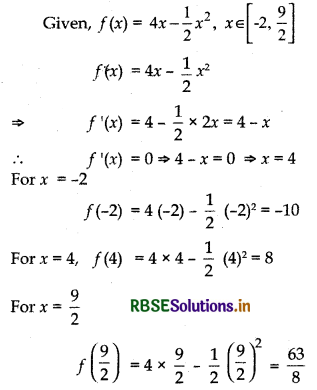
Thus, absolute maximum value of function = 8
And absolute minimum value = - 10

(iv) f(x) = (x - 1)2 + 3, x ∈ [- 3, 1]
Answer:
Given, f(x) = (x - 1)2 + 3, x ∈ [- 3, 1]
f(x) = (x - 1)2 + 3
⇒ f’(x) = 2(x - 1)
∴ f(x) = 0
⇒ 2(x - 1) = 0
⇒ x = 1
For x = - 3
f(- 3) = ( - 3 - 1)2 + 3
= (-4)2 + 3 = 16 + 3 = 19
For x = 1 f(1) = (1 - 1)2 + 3 = 0 + 3 = 3
Thus, absolute maximum value of function = 19
And absolute minimum value = 3
Question 6.
Find the maximum profit that a company can make, if the profit function is given by
p(x) = 41 - 72x - 18x2
Answer:
Profit function
p(x) = 41 - 72x - 18x2
Differentiating w.r.t. x
⇒ p’(x) = - 72 - 36x
For maximum profit p’(x) = 0
∴ p’(x) = 0 ⇒ - 72 - 36x = 0
⇒ 36x = - 72 ⇒ x = - 2
Again, differentiating equation (1) w. r. t.
p(x) = - 36
For x = - 2,
p’(x) = - 36 < 0
Thus, company has maximum profit.
At x = - 2, maximum profit of company
= 41 - 72(- 2)- 18 (- 2)2
= 41 + 144 - 72 = 113 unit
Question 7.
Find both the maximum value and minimum value of 3x4 - 8x3 + 12x2 - 48x + 25 on the interval [0, 3].
Answer:
Let f(x) = 3x4 - 8x3 + 12x2 - 48x + 25, x ∈ [0, 3]
Differentiating w. r. t. x
⇒ f’(x) = 12x3 - 24x2 + 24x - 48
For maxima and minima f’(x) = 0
∴ f'(x) = 0
⇒ 12x3 - 24x2 + 24x - 48 = 0
⇒ 12(x3 - 2x2 + 2x - 4) = 0
⇒ 12[x2 (x - 2) + 2 (x - 2)] = 0
⇒ 12 (x2 +2) (x -2) = 0
⇒ x2 + 2 = 0 or x - 2 = 0
⇒ x2 = - 2 or x = 2
⇒ x = ± √- 2 or x = 2
But x = ±√-2 is not possible. Since it is not a real number.
Thus, x = 2
At x = 0, value of function
f(0) = 3 × 04 - 8 × 03 + 12 × 02 - 48 × 0 + 25 = 25
At x = 2, value of function
f(2) = 3 × 24 - 8 × 23 + 12 × 22 - 48 × 2 + 25
= 48 - 64 + 48 - 96 + 25 = - 39
At x = 3 value of function
f(3) = 3 × 34 - 8 × 33 + 12 × 32 - 48 × 3 + 25
= 243 - 216 + 108 - 144 + 25
= 376 - 360 = 16
Thus, absolute maximum value of function 25 (at x = 0)
And absolute minimum value = -39 (at x = 2)

Question 8.
At what points in the interval [0, 2π], does the function sin 2x attain its maximum value?
Answer:
Let f(x) = sin 2x ⇒ f ‘(x) = 2 cos 2x
∴ f’(x) = 0 ⇒ 2 cos 2x = 0
⇒ cos 2x = 0 ⇒ cos 2x = cos \(\frac{\pi}{2}\)
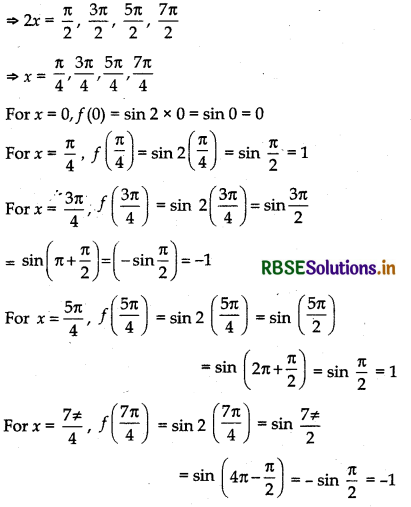
x = 2π, then f(2π) = sin 2(2π) = sin 4π = 0
Thus maximum value of function = 1.
Thus, in interval [0, 2π] at points \(\frac{\pi}{4}\) and \(\frac{5 \pi}{4}\) value of function is maximum.
Question 9.
What is the maximum value of the function sin x + cos x?
Answer:
Let f(x) = sin x + cos x, x ∈ [0, 2π]
⇒ f'(x) = cos x - sin x
For maximum value, f'(x) = 0
⇒ cos x - sin x = 0 ⇒ cos x = sin x
⇒ tan x = 1 = tan \(\frac{\pi}{4}\)
⇒ x = \(\frac{\pi}{4}\), \(\frac{5 \pi}{4}\)
For x = 0, f(0) = sin 0 + cos 0 = 0 + 1 = 1
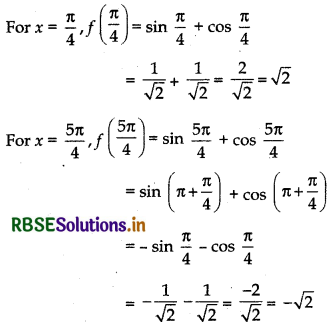
For x = 2π, f(2π) = cos 2π + sin 2π = 1 + 0 = 1
Thus, maximum value of fraction = √2
Question 10.
Find the maximum value of 2x3 - 24x + 107 in the interval [1, 31. Find the maximum value of the same function in [- 3, - 1l.
Answer:
Let f(x) = 2x3 - 24x + 107
⇒ f’(x) = 6x2 - 24
∴ f’(x) = 0 ⇒ 6x2 - 24 = 0
⇒ 6x2 = 24
⇒ x2 = 4
⇒ x = ±2 (∵ - 2 ∉ [1, 3])
∴ x = 2, since 2 ∈ [1, 3]
At x = 1 value of function
f(1) = 2 × 13 - 24 × 1 + 107
= 2 - 24 + 107 = 85
At x = 2 value of function
f(2) = 2 × 23 - 24 × 2 + 107
= 16 - 48 + 107 = 75
At x = 3 value of function
f(3) = 2 × 33 - 24 × 3 + 107
= 54 - 72 + 107 = 89
Thus, in interval [1, 3], at x = 3, maximum value of function is 89.
Now, for interval [- 3, - 1]
f(x) = 2x3 - 24x + 107
⇒ f’(x) = 6x2 - 24
∴ f('x) = 0 ⇒ 6x2 - 24 ⇒ x2 = 24
⇒ x = ±2 ⇒ x = 2, x = - 2
But, 2 ∉ [-3, -1], so x = -2
For x = -3
f(- 3) = 2 (- 3)3 - 24 (- 3) + 107 = 125
For x = - 2
f(- 2) = 2(- 2)3 - 24 (- 2) + 107 = 139
For x = - 1
f(- 1) = 2 (- 1)3 - 24 (- 1) + 107 = 129
Thus, in interval [- 3, -1] at x - 2 maximum value of function is 139.

Question 11.
It is given that at x = 1, the function x4 - 62x2 + ax + 9 attains its maximum value, on the interval [0, 2]. Find the value of a.
Answer:
Let f(x) = x4 - 62x2 + ax +9
Differentiating w. r. t. x
f'(x) = 4x3 - 124x + a = 0
At x = 1 value of function is maximum.
⇒ f’(1) = 0 ⇒ 4(1)3 ⇒ 124 × 1 + a = 0 ....... (1)
⇒ 4 - 124 + a = 0 ⇒ a = 124 - 4 = 120
Again, differentiating equation (1) w. r. t. x
f”(x) = 12x2 - 124
For x = 1
f”(x) = 12 × 12 - 124
= 12 - 124 = - 112 < 0
Thus, at x = 1, f is maximum then a = 120
Question 12.
Find the maximum and minimum values of x + sin 2x on [0, 2π].
Answer:
Let f(x) = x + sin 2x
⇒ f’(x) = 1 + 2 cos 2x
For maxima and minima f'(x) = 0
∴ f(x) = 0 ⇒ 1 + 2 cos 2x = 0
2 cos 2x = - 1 ⇒ cos 2x = - \(\frac{1}{2}\)
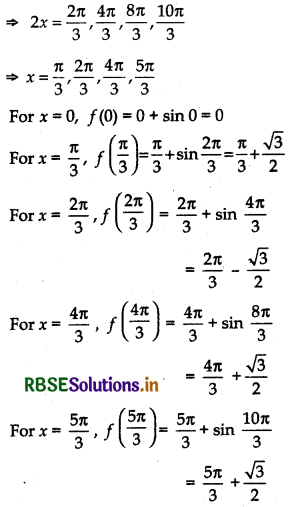
For x = 2π, f(2π) = 2π + sin 2π = 2π
∴ Maximum value of f(x) = 2π
Minimum value of f(x) = 0
Question 13.
Find two numbers whose sum is 24 and whose product is as large as possible.
Answer:
Let numbers are x and 24- x and their product is P(x).
∴ P(x) = x(24 -x) = 24x - x2
Differentiating w. r. t. x
P'(x) = 24 - 2x ........ (1)
P (x) will be maximum If P’(x) = 0
∴ P(x) = 0 ⇒ 24 - 2x = 0
⇒ x = 12
Again, differentiating equation (1) w. r. t. x
P''(x) = - 2
For x = 12, p''(x) = - 2 < 0
Thus, product is maximum when x = 12.
Hence, required numbers are 12, 12.
Question 14.
Find two positive numbers x and y such that x + y = 60 and xy3 is maximum.
Answer:
We have, x + y ⇒ 60 ⇒ y = 60 - x
Let P(x) = xy3 = x (60 - x)3
∴ P(x) = x (60 - x)3
Differentiating w.r.t. x
P(x) = 1. (60 - x)3 + x × 3 (60 - x)2 (- 1)
⇒ P(x) = (60 - x)3 - 3x (60- x)2 ........ (1)
P (x) will be maximum if P(x) —0
∴ P(x) = 0
⇒ (60 - x)3 - 3x(60 - x)2 = 0
⇒ (60 - x)2 (60 - x - 3x) = 0
⇒ (60 - x)2 (60 - 4x) = 0
⇒ (60 - x)2 = 0 or (60 - 4x) = 0
⇒ x = 60 or 4x = 60 or x = 15
But x ≠ 60 ∴ x = 15
Differentiating equation (1) w. r. t. x
P''(x) = 3(60 - x)2 (- 1) - 3 [(60 - x)2 (1) + 2x (60 - x) (- 1)]
⇒ P’(x) = - 3(60 - x)2 - 3(60 - x)2 + 6x(60 - x)
For x = 15
P’(15) = - 3 (60 - 15)2 - 3 (60 - 15)2 + 6 × 15 (60 - 15)
= - 3(45)2 - 3 (45)2 + 90 × 45
= - 3 × 2025 - 3 × 2025 + 90 × 45
= - 6075 - 6075 + 4050
P''(15) = - 12150 + 4050 = - 8100 < 0
Thus, P(x) is maximum when x = 15
y = 60 - x = 60 - 15 = 45
Hence, 15 and 45 are required numbers

Question 15.
Find two positive numbers x and y such that their sum is 35 and the product x2y2? is maximum.
Answer:
We have, x + y = 35
∴ y = 35 - x .......... (1)
Again, let
P(x) = x2y5 = x2(35 - x)5 [From(1)]
∴ P(x) = x2(35 - x)5
Differentiating w. r. t. x
P(x) = 2x (35 - x)5 + 5x2 (35 - x)4 (- 1)
⇒ P(x) = 2x(35 - x)5 - 5x2(35 - x)4 ........ (2)
For maxima of P(x), P'(x) = 0
∴ P'(x) = 0
⇒ 2x(35 - x)5 - 5x2(35 - x)4 = 0
⇒ x(35 - x)4 {2(35 - x) - 5x)} = 0
⇒ x(35 - x)4 (70 - 2x - 5x) = 0
⇒ x(35 - x)4 (70 - 7x) = 0
⇒ x = 0 or x = 35 or 7x = 70
⇒ x = 0, x = 35 or x = 10
But x ≠ 0, x ≠ 35
Thus, x = 10
Again, differentiating equation (2) w. r. t. x
P(x) = 2 (35 - x)5 + 10x (35 - x)4 (- 1) - 10x (35 - x )4 - 20x2 (35 - x)3 (-1)
P''(x) = 2(35 - x)5 - 10x (35 - x)4 - 10x (35 - x )4 + 20x2 (35 - x)3
For x = 10
P''(x) = 2 (35 - 10)5 - 10 × 10 (35 - 10)4 - 10 × 10 (35 - 10)4 + 20 × 102 (35 - 10)3
= 2 × 255 - 100(25)4 - 100(25)4 + 2000 (25)3
= 253(2 × 252 - 100 × 25 - 100 × 25 + 2000)
= 253(1250 - 2500 - 2500 + 2000)
= 253(1250 - 5000 + 2000)
∴ P''(x) = - 1750 × 253 < 0
Thus, P(x) is maximum when x < 10.
∴ x = 10, then y = 35 - 1025 [from eqn. (1)]
Hence, required numbers are 10 and 25.
Question 16.
Find two positive numbers whose sum is 16 and the sum of whose cubes is minimum.
Answer:
Let x and 16 - x are two numbers.
and S (x) = x3 + (16 - x)3
Differentiating w. r. t. x
S‘(x) = 3x3 + 3 (16 - x)2 (- 1)
⇒ S’(x) = 3x2 - 3(16 - x)2
S(x) will be minimum if S ‘(x) = 0.
∴ S’(x) = 0 ⇒ 3x2 - 3(16 - x)2 = 0
⇒ x2 - (16 - x)2 = 0 ⇒ x2 - (256 + x2 - 32x) = 0
⇒ x2 - 256 - x2 + 32x = 0 ⇒ 32x - 256 = 0
⇒ x = \(\frac{256}{32}\) = 8
Again, differentiating equation (1) w. r.t. x
S”(x) = 6x - 6(16 - x) (—1)
⇒ S(x) = 6x + 6(16 - x)
For, x = 8
S’(8) = 6 × 8 + 6(16 - 8)
= 48 + 6 × 8 = 48 + 48 = 96 > 0
Thus, S(x) will be minimum when x = 8.
Second number = 16 - 8 = 8
Hence, 8 and 8 are required numbers.

Question 17.
A square piece of tin of side 18cm is to be made into a box without top, by cutting a square from each corner and folding up the flaps to form the box. What should be the side of the square to be cut off so that the volume of the box is the maximum possible.
Answer:
Let ABCD is a square piece of tin of side 18 cm.
Again, let square of side x cm is cut off from each corner of tin.
Thus, dimensions of tin box are
length (l) = (18 - 2x) cm
breadth (b) = (18 - 2x) cm
and height (h) = x cm
Let V be volume of box.
Then V = l × b × h (18 - 2x) × (18 - 2x) × x
⇒ V = x(18 - 2x)2
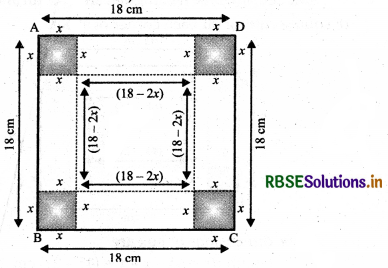
Differentiating w. r. t. x
\(\frac{d V}{d x}\) = 1.(18 - 2x)2 + x × 2(18 - 2x)(- 2)
⇒ \(\frac{d V}{d x}\) = (18 - 2x)2 - 4x (18 - 2x) ........ (1)
V will be maximum, \(\frac{d V}{d x}\) = 0
⇒ (18 - 2x)2 - 4x(18 - 2x) = 0
⇒ (18 - 2x) (18 - 2x - 4x) = 0
⇒ (18 - 2x) (18 - 6x) = 0
⇒ 18 - 2x = 0 or 18 - 6x = 0
⇒ 18 = 2x or 18=6x
⇒ x = 9 or x = 3
But x ≠ 9, so x = 3
Again, differentiating equation (1) w. r. t. x
\(\frac{d^{2} V}{d x^{2}}\) = 2(18 - 2x)(- 2) - 4[1(18 - 2x) + (- 2)x]
= - 4(18 - 2x) - 4(18 - 2x) + 8x
= - 8(18 - 2x) + 8x - 144 + 16x + 8x
\(\frac{d^{2} V}{d x^{2}}\) = - 144 + 24x
For x = 3
\(\frac{d^{2} V}{d x^{2}}\) = - 144 + 24 × 3 = - 144 + 72 = - 72 < 0
dxVolume will be maximum when x = 3.
Thus, side of cutting square should be 3 cm. Then volume of box will be maximum.
Question 18.
A rectangular sheet of tin 45 cm × 24 cm is to be made into a box without top, by cutting off square from each comer and folding up the flaps. What should be the side of the square to be cut off so that the volume of the box is maximum?
Answer:
Let ABCD be rectangular sheet of tin and x be side of square cutting off each comer of sheet.
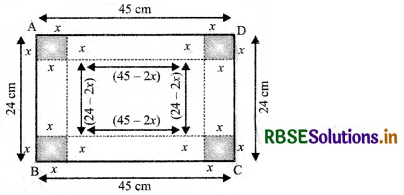
Thus, dimensions of box are
length (l) = 45 - x - x = (45 - 2x) cm
breadth (b) = 24- x — x = (24 - 2x) cm
and height (h) = x cm
Let V be volume of the box, then
V = l × b × h
⇒ V(45_2x)(24_2x)xx
⇒ V = 4x3 - 138x2 + 1080x
Differentiating w. r. t. x
\(\frac{d V}{d x}\) = 12x2 - 276x + 1080
V will be maximum, if \(\frac{d V}{d x}\) = 0
⇒ 12x2 - 276x + 1080 = 0
⇒ 12(x2 - 23x + 90) = 0
⇒ x2 - 23x + 90 = 0
⇒ x2 - (18 + 5)x + 90 = 0
⇒ x2 - 18x - 5x + 90 = 0
⇒ x(x - 18) - 5(x - 18) = 0
⇒ (x - 18) (x - 5) = 0
⇒ x ≠ 18 or x = 5
Again, differentiating equation (1) w. r. t. x
\(\frac{d^{2} V}{d x^{2}}\) = 24x - 276
For x = 5, \(\frac{d^{2} V}{d x^{2}}\) = 24 × 5 - 276 = - 156 < o
At x = 5 volume will be maximum.
Thus, side of cuffing square should be 5 cm then volume will be maximum.

Question 19.
Show that of all the rectangles inscribed in given fixed circle, the square has the maximum area.
Answer:
Let rectangle ABCD is inscribed in a given circle with center O and radius a and length and breadth of rectangle are x and y respectively as shown in following figure.
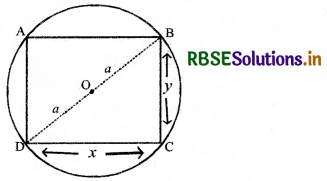
In right-angled ΔABCD
x2 + y2 = (2a)2 = 4a2
⇒ y2 = 4a2 - x2 ⇒ y = \(\sqrt{4 a^{2}-x^{2}}\)
Let A be area of rectangle
∴ A = xy
Putting value of y
⇒ A = x\(\sqrt{4 a^{2}-x^{2}}\) (on squaring)
⇒ A2 = x2(4a2 - x2)
⇒ A2 = 4a2x2 - x4
Differentiating w. r. t. x
2A\(\frac{d A}{d x}\) = 4a2(2x) - 4x3
⇒ A\(\frac{d A}{d x}\) = 4a2x - 2x3 ....... (1)
A will be maximum, if \(\frac{d A}{d x}\) = 0
⇒ 4a2x - 2x3 = 0 [∵ A ≠ 0]
⇒ 2x(2a2 - x2) = 0 ⇒ 2a2 - x2 = 0 [∵ x ≠ 0]
⇒ x2 = 2a2
∴ x = a√2
Again, differentiating equation (1) w.r.t. x
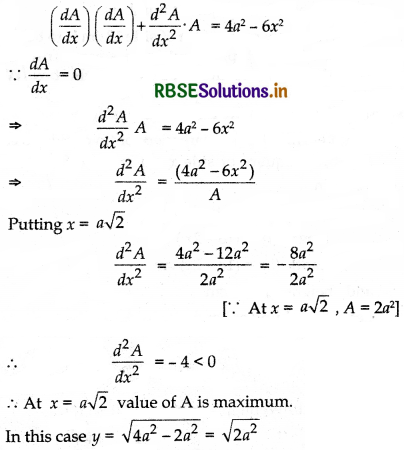
y = a√2
∴ Sides of rectangle x = y = a√2
Thus, at maximum area rectangle is a square.
Question 20.
Show that the right circular cylinder of given res surface and maximum volume is such that its height is equal to the diameter of the base.
Answer:
Let surface area of cy1indr S
Radius r, Height = h, Volume = V
Now, surface area of cylinder
S = 2πr2 + 2πrh ⇒ 2πrh = S - 2πr2
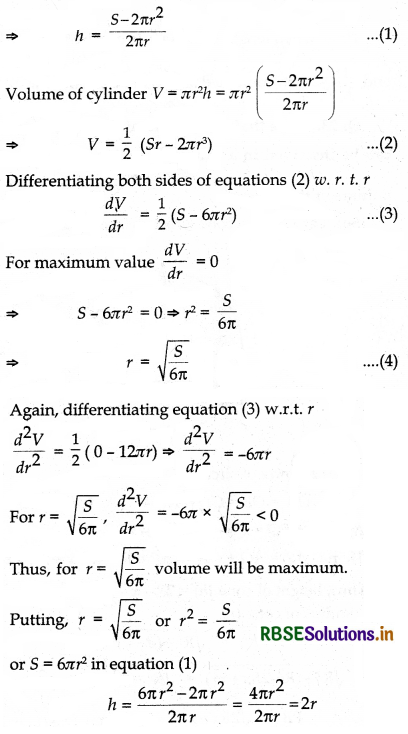
∴ Height of cylinder (h) = 2r = (diameter of base)
Thus, when diameter of base and height of cylinder are equal then volume of cylinder will be maximum.
Hence Proved.

Question 21.
Of all the closed cylindrical cans (right circular), of a given volume of 100 cubic centimetres, find the dimensions of the can which has the minimum surface area?
Answer:
Let r and h be radius and height of cylindrical can respectively.
Volume, V = πr2h = 100
⇒ h = \(\frac{100}{\pi r^{2}}\) ....... (1)
Let S be surface area of cylinderical can.
S = 2πr2h + 2πrh ........ (2)
Putting value of h from equation (1) in equation (2)
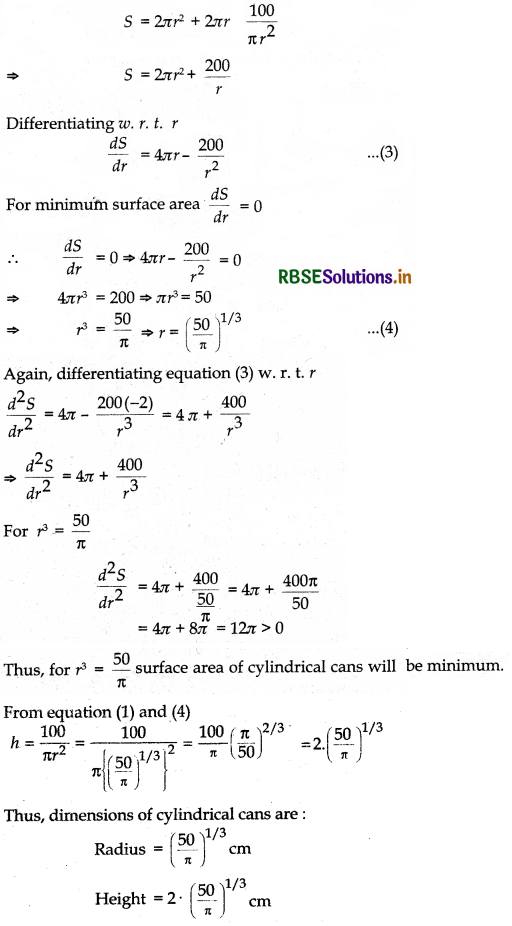
Question 22.
A wire of length 28 m is to be cut into two pieces. One of the pieces is to be made into a square and the other into a circle. What should be the length of the two pieces so that combined area of the square and the circle is minimum?
Answer:
Let one part of wire be x cm then length of other part = (28 - x) cm
Let from a wire of length x, a circle of radius r is made.
Then circumference of circle = 2πr = x
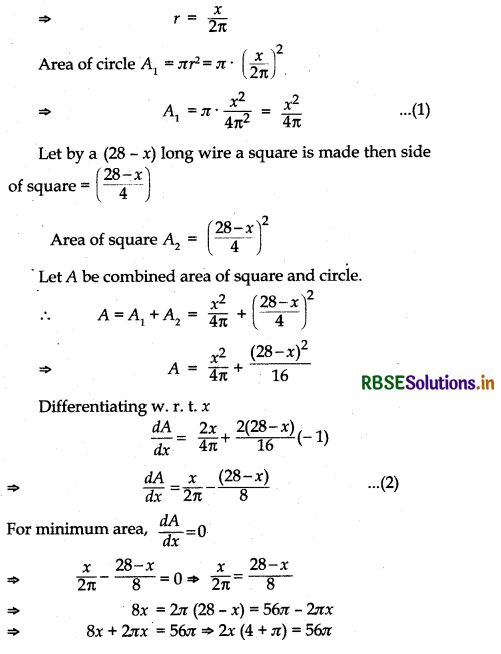
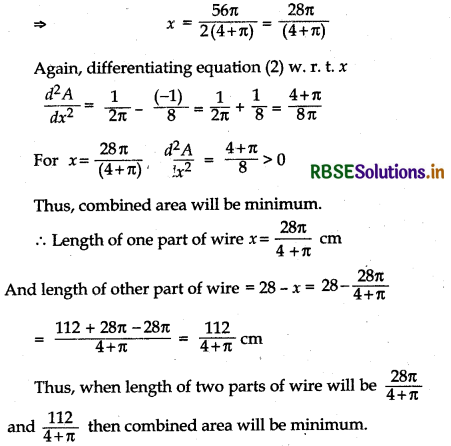

Question 23.
Prove that the volume of the largest cone that can be inscribed in a sphere of radius R is \(\frac{8}{27}\) of the volume of the sphere.
Answer:
Let ABC is a cone which is inscribed in a circle of radius R.
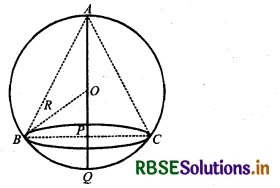
O is the centre of circle.
Thus, OA = OB = QQ = R (radius of circle)
Again let PQ = x ⇒ OP = (R - x)
Then AP = AO + OP ⇒ AP = R + R - x = 2R - x
Thus, height of cone (h) = 2R - x
Radius of cone (r)
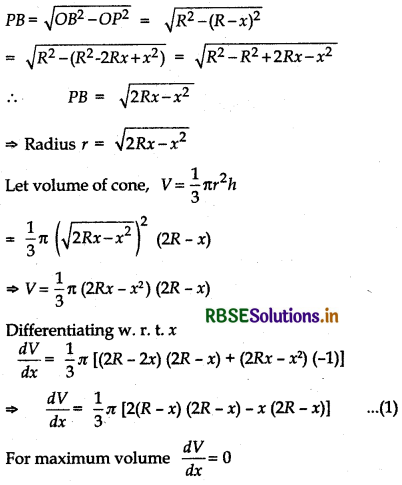
⇒ \(\frac{1}{3}\)π [2(R - x )(2R - x) - x (2R - x)] = 0
⇒ (2R -x ) [(2(R - x) - x] = 0
⇒ (2R - x) (2R - 2x - x) = 0
⇒ (2R - x) (2R - 3x) = 0
⇒ 2R - x = 0 or (2R - 3x) = 0
⇒ x = 2R or 2R = 3x
⇒ x = 2R or x = \(\frac{2 R}{3}\)
x ≠ 2R then x = \(\frac{2 R}{3}\)
Differentiating both sides of equation (1) w. r. t. x
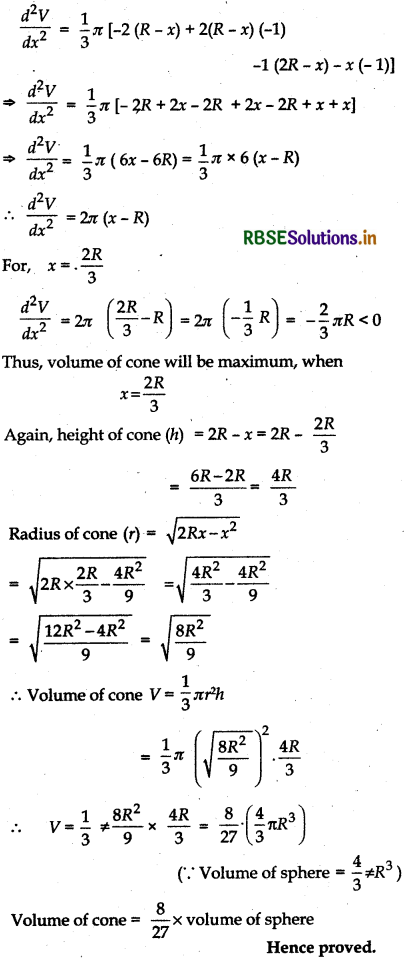

Question 24.
Show that the right circular cone of least curved surface and given volume has an altitude equal to times the radius of the base.
Answer:
Let r, h and V be radius, height and volume of cone respectively.
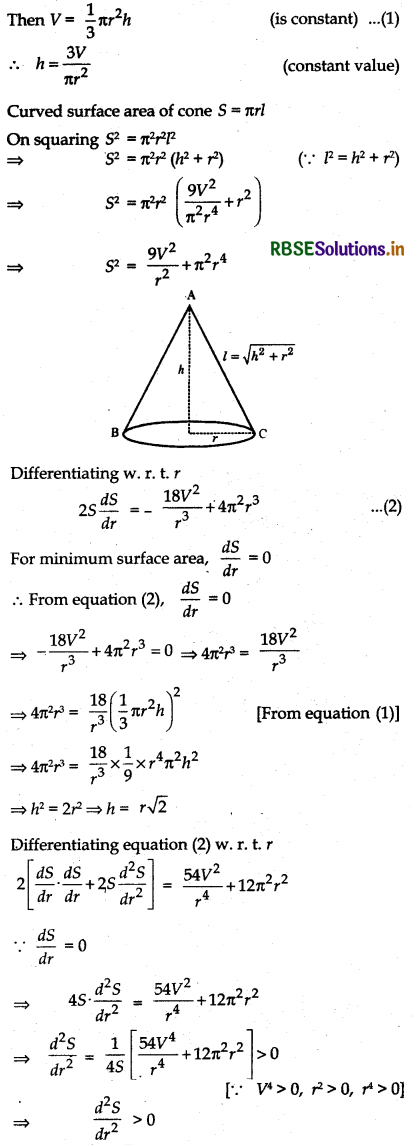

Question 25.
Show that the semi-vertical angle of the cone of the maximum volume and of given slant height is tan-1 √2.
Answer:
Let radius of cone = r
Height of cone = h
Slant height of cone = 1
Volume of cone = V
Semi-vertex angle of cone = α
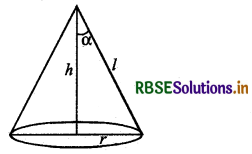
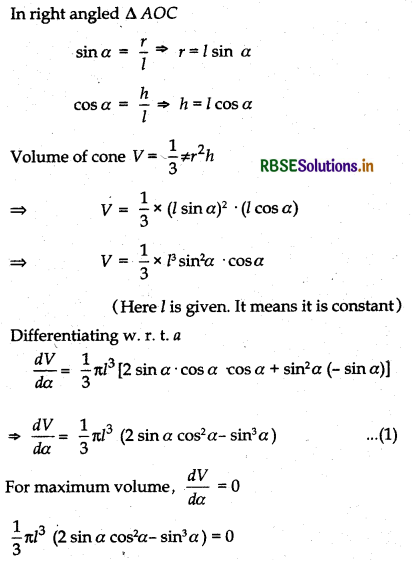
⇒ 2 sin α cos2α - sin3α = 0
⇒ sin α (2 cos2α - sin2α) = 0
⇒ sin α = 0 or 2 cos2α - sin2α = 0
But sin α ≠ 0
Thus 2 cos2α - sin2α = 0
⇒ 2 = \(\frac{\sin ^{2} \alpha}{\cos ^{2} \alpha}\) = tan2 α
⇒ tan2 α = 2 ⇒ tan α = √2
Again. differentiating equation (1) w. r. t. a
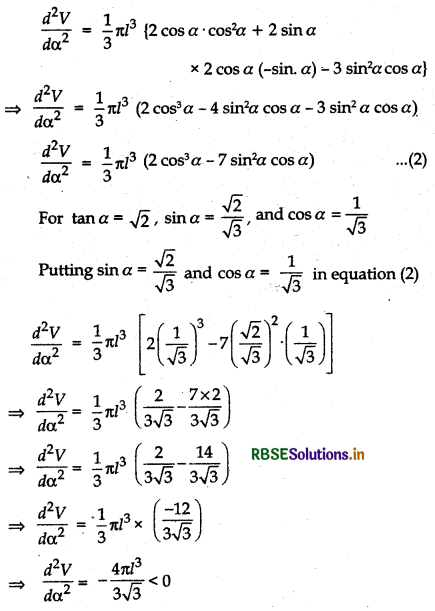
Thus, for tan α = √2 volume is maximum.
Thus, volume will be maximum when semi-vertical angle of cone will be tan-1 √2.
Hence Proved.

Question 26.
Show that the semi-vertical angle of right circular cone of given surface area and maximum volume is sin-1\(\left(\frac{1}{3}\right)\).
Answer:
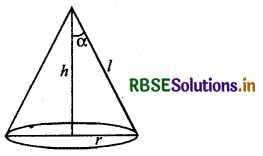
Let slant height of cone = l
Height = h
Radius = r
Total surface area = S
Volume = V
Semi- angle = α
Total surface area of cone = πr2 + πrl
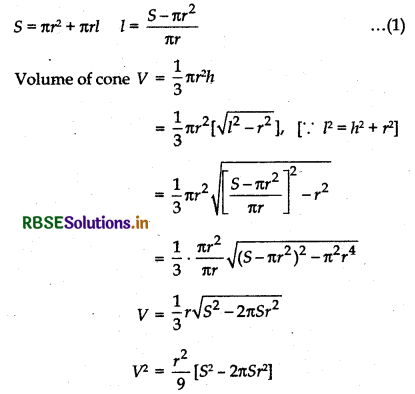
Clearly, for given S, when V will be maximum and minimum then V2 will be maximum/minimum.
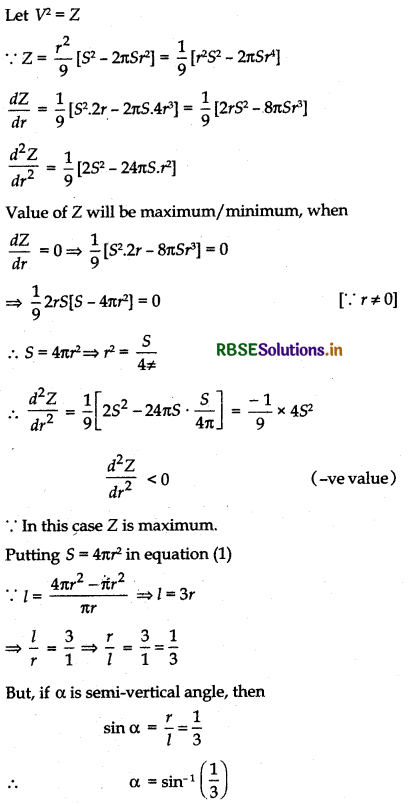
Thus, when semi-vertical angle of cone is sin-1\(\left(\frac{1}{3}\right)\) then volume is maximum.
Hence Proved.

Choose the correct answer from Q. 27 to Q. 29.
Question 27.
The point on the curve x2 = 2y which is nearest to the point (0, 5) is:
(A) (2√2, 4)
(B) (2√2, 0)
(C) (0, 0)
(D) (2, 2)
Answer:
Let point P(x, y) lies on curve x2 = 2y which is at minimum distance to the point A (0, 5).
PA = \(\sqrt{(x-0)^{2}+(y-5)^{2}}\)
Then, PA2 = (x - 0)2 + (y - 5)2 = D (say)
∴ D = x2 + (y - 5)2
Curve x2 = 2y
From equations (1) and (2)
D = 2y + (y - 5)2 = 2y + y2 - 10y + 25
⇒ D = y2 - 8y + 25
Differentiating w. r. t.y
\(\frac{d D}{d y}\) = 2y - 8
For maximum or minimum D, \(\frac{d D}{d y}\) = 0
∴ \(\frac{d D}{d y}\) = 0 ⇒ 2y - 8 = 0 ⇒ y = 4
Again, differentiating equation (3) w. r. t. y
\(\frac{d^{2} D}{d y^{2}}\) = 2
For y = 4, \(\frac{d^{2} D}{d y^{2}}\) = 2 > 0
Distance D is minimum.
Putting y = 4 in equation (2)
x2 = 2 × 4 = 8 ⇒ x = 2√2
∴ (2√2, 4) is required point.
Thus (A) is correct.
Question 28.
For all the values if x, the minimum value of \(\frac{1-x+x^{2}}{1+x+x^{2}}\) is:
(A) 0
(B) 1
(C) 3
(D) \(\frac{1}{3}\)
Answer:
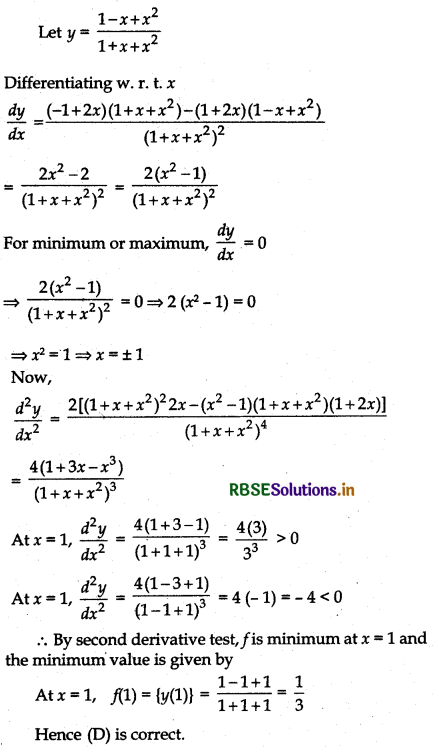

Question 29.
The maximum value of [x(x - 1) + 1]1/3, 0 ≤ x ≤ 1 is:
(A) \(\left(\frac{1}{3}\right)^{1 / 3}\)
(B) \(\frac{1}{2}\)
(C) 1
(D) 0
Answer:
Let y = [x(x - 1) + 1]1/3 = (x2 - x + 1)1/3
⇒ y = (x2 - x + 1)1/3
Differentiating w.r.t. x
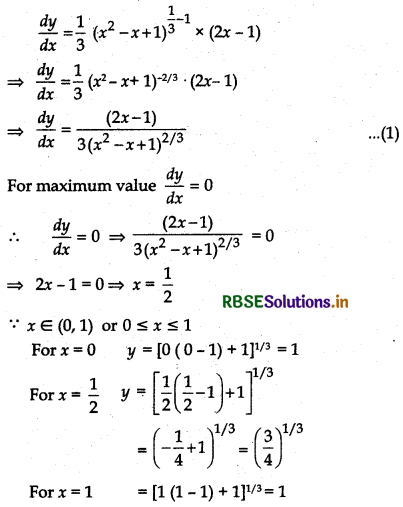
Thus, maximum value of function is 1.
∴ (C) is correct.

- RBSE Class 12 Maths Notes Chapter 13 Probability
- RBSE Class 12 Maths Notes Chapter 12 Linear Programming
- RBSE Class 12 Maths Notes Chapter 11 Three Dimensional Geometry
- RBSE Class 12 Maths Notes Chapter 10 Vector Algebra
- RBSE Class 12 Maths Notes Chapter 9 Differential Equations
- RBSE Class 12 Maths Notes Chapter 8 Application of Integrals
- RBSE Class 12 Maths Notes Chapter 7 Integrals
- RBSE Class 12 Maths Notes Chapter 6 Application of Derivatives
- RBSE Class 12 Maths Notes Chapter 5 Continuity and Differentiability
- RBSE Class 12 Maths Notes Chapter 4 Determinants
- RBSE Class 12 Maths Notes Chapter 3 Matrices